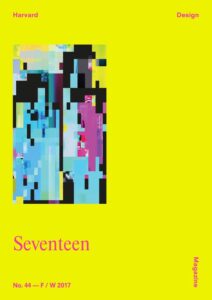Question Guys
It’s Armando Contreras’s first day back at work after an extended vacation, and though he has pans to scrub and receipts to tabulate, followed by a long commute home to the southern fringes of Mexico City, he isn’t complaining. Standing in the kitchen of Comedor Café Wi-Fi Café Zena, in San Miguel Chapultepec, he smiles and says, “I live a great life.”1 For the past six months, the 30-year-old designer and artist, who goes by Armani, has been drawing and reading and going to parties. Never mind that his wallet contained less than 10 pesos—the equivalent, roughly, of two subway rides or one taco al pastor or half a US dollar. Armani survives, you could say, by his personality. Hyper-empathic, he barters with sensations, experiences. A chatty stroll in exchange for a beer. His friends tell him not to worry, that they’ll pay.
I met Armani less than three hours ago. Already, I have paid him 80 pesos, for lunch. By an arrangement with the café’s experiment-courting proprietors, Armani is “in residence,” preparing lunch daily, Monday through Friday, together with his friend Gerardo Arellano, a young cook and baker whose primary trade is catering music festivals. Armani has limited his experiment to six months, maximum; but he can stop whenever he wants. “I have the freedom I’ve searched for for a long time,” he says. “If I don’t want to open for a week, I don’t have to.”
Sure, Armani can do as he wishes. But that isn’t to say he doesn’t care how you feel. After customers finish their meals and pay, he hands them a survey to fill out, if they want. It’s a ritual you’d expect at a corporate establishment concerned with performance metrics, not the type of restaurant where artists get free rein of the kitchen, the Wi-Fi password is “trolltrolltroll,” and food probably won’t be ready until 45 minutes after the appointed opening time.
Yet feedback is the essence of Café Zena. Everything from the seating arrangement (a single table runs the length of the space, into a light well open to the sky, with just one interruption) to the loose operational format (rotating cooks, one-off events) conspires to create an atmosphere of experimentation and conviviality.
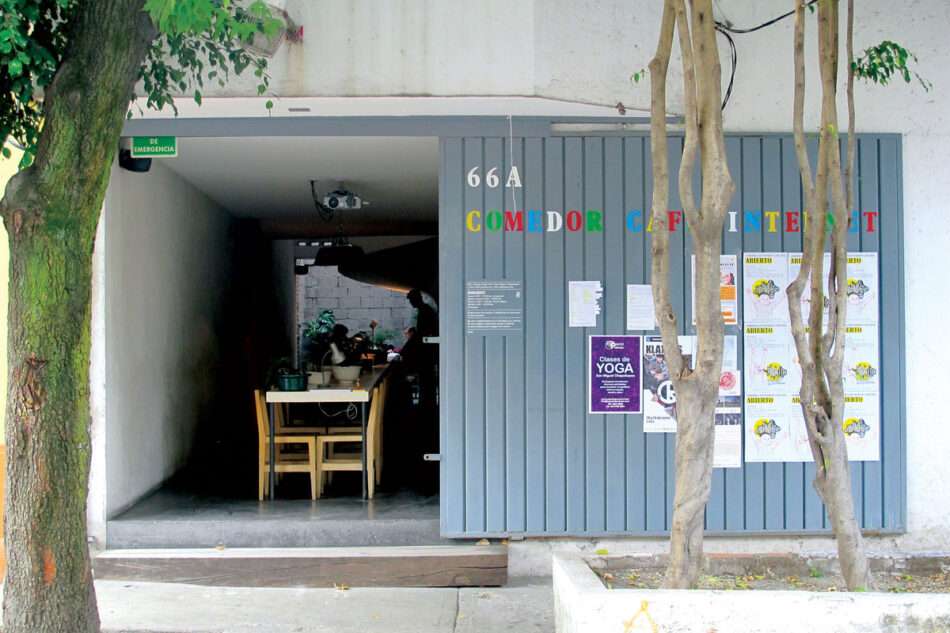
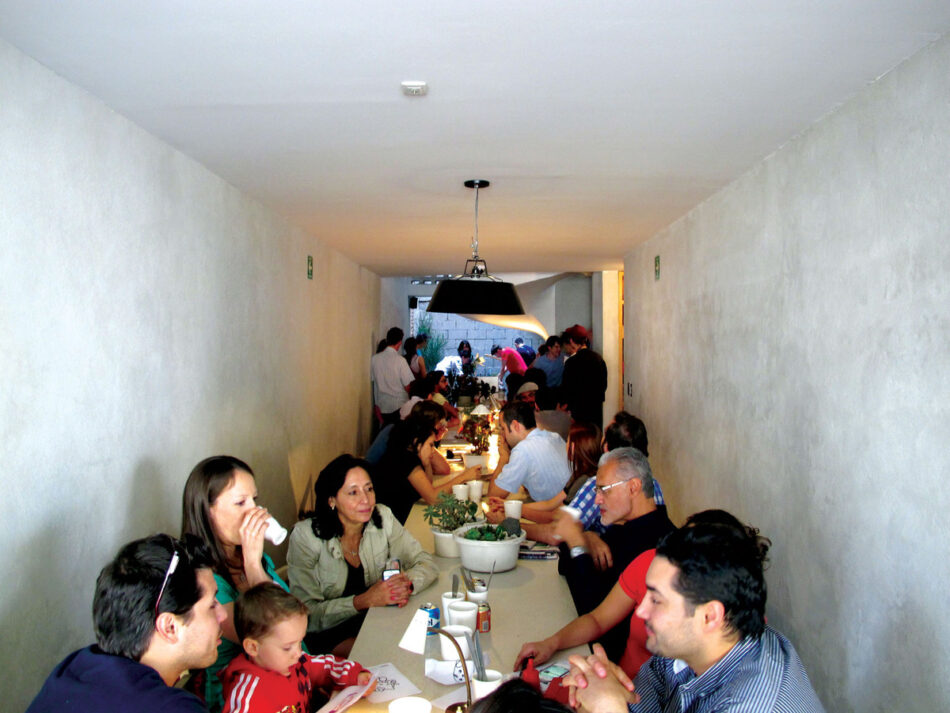
All of it is by design. And even its impresarios are designers. But a run-down of size (80 square meters), lighting (a random variety of desk lights on the table, and, in the bathroom, a rotating multicolor disco ball), and materials (gray plaster walls, concrete floors) will tell you very little. To start to understand this place, you have to see it as one thing among many others, all connected. Imagine vectors pointing out in all different directions across Mexico City, persons and things linking Café Zena with a constellation of other “subspaces” run by the umbrella entity ELHC, both past and present: CBR (Comidas, Bebidas, Revistas), a now-defunct convenience store with two branches; Muebles Sullivan, a furniture showroom and café; and Macolen, a storefront print studio. To understand the singularity of ELHC, and its significance as an approach to design, you have to talk to people, trace itineraries, immerse yourself in a community. Which is what I did over the course of a week this past May.
If there’s a center to this tangled consortium, it is ELHC’s cofounders and their respective offices. Manuel Bueno, who goes by Manny, heads the graphic design studio Pesca al Curricán. And Rodrigo Escandón and Guillermo González, who go by Ro and Willy, run an architecture practice called APRDELESP. The subspaces function as infrastructure for the offices—places where vague, unwieldy abstractions like “the social” or “collaboration” or “public space” are manifest as lived experience, complicated and messy. The designers use them to conduct research and retrieve information (“information” is one of their favorite words), but never from a distance. Manny, Ro, and Willy—who were born, like myself and most people who congregate around ELHC, between the mid-1980s and early 1990s—are right there in the spaces, living and working and trying to figure things out.
One Monday night we’re sitting at one end of the long table in Café Zena—Ro, Willy, and I, and Ricardo Matias, a Portuguese architect who joined APRDELESP in 2014, two years after the firm was founded. The three of them spend most weekdays working here, on laptops, while the café carries on around them. Friends stop in with little to no notice. Strangers appear and new relationships are forged— relationships of the personal or professional variety, or, more often than not, a combination of the two. These friends might even embed a link to Radio Amigos, ELHC’s open-format internet station, somewhere on their own websites.
A pair of lozenge-shaped eyeballs collaged onto random bits of clip art, the “amigo” icon is a kind of badge that extends, literally and symbolically, ELHC’s hyper-local community farther out into the world. Ro and Willy go on and on about its meaning. Ricardo, the least loquacious of the bunch by far, explains the significance succinctly: “It’s not [about] having the amigo, but the connections it brings to us.”2
“It’s a connection,” Willy says, energetically, as though a 250-watt light bulb has gone off in his head. “We didn’t start Radio Amigos because we wanted a radio station. It began because one of the people who was doing events here—our relationship with him got very intense, and he wanted to make this project with us. I think that’s the most interesting thing. People come to these spaces, begin a conversation with us, and this conversation doesn’t stop—it evolves.”
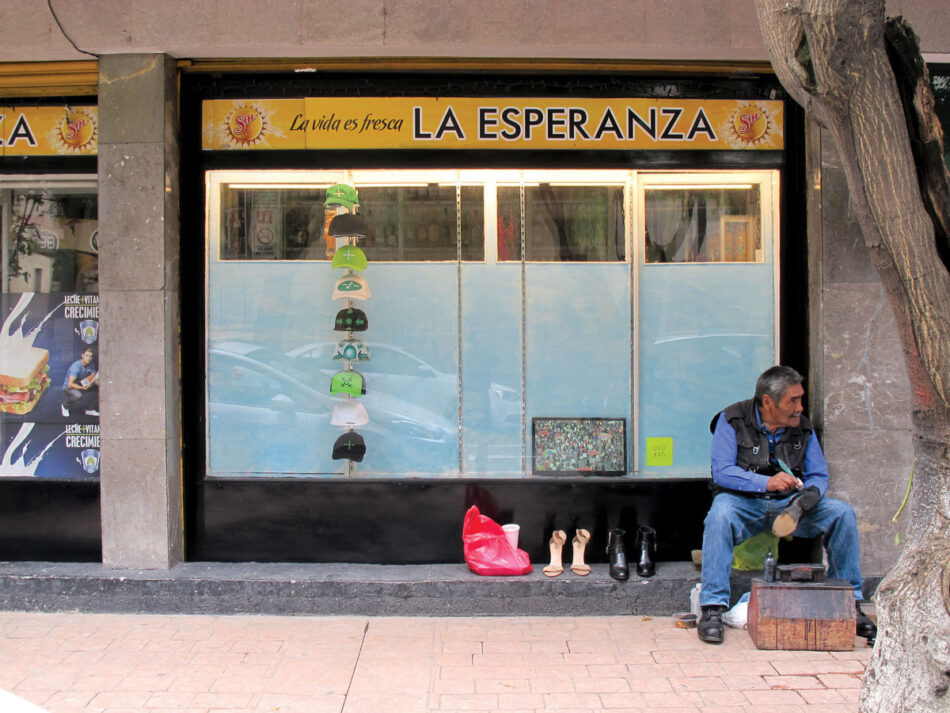
Consider Bree Zucker, an American art dealer who moved to Mexico City three years ago from New York City. On the day she arrived, she had an iced latte at Muebles Sullivan. Later, she visited Café Zena, without knowing it was operated by the same people as Muebles Sullivan. Eventually, Bree met Ro and Willy. They became friends and argued a lot. Last year, they opened a new ELHC subspace together: Galería La Esperanza, a closet-size exhibition space located in a bodega storefront one block from Café Zena. The subspaces are enablers, but just as important, they are magnets for a type of person who, like Armani or Bree, wants to get involved.
I meet Bree one Thursday night at Muebles Sullivan, at a celebration marking the conclusion of the gallery’s latest show (Diego Salvador Rios, the artist exhibiting, oversaw the Café Zena kitchen for a time). The DJ cues up music on his MacBook, which is plugged into a projector, and sources visual pleasures—YouTube videos and box-blurred anime from Xtube. I take a seat on a three-legged stool, part of the system of white metal furniture that is available for purchase in the café. “When I first showed up, I wanted to make an art bar,” Bree tells me.3 She was concerned that people in the art scene weren’t talking; groups weren’t hanging out together. The bar never materialized, but weekly karaoke parties at Muebles Sullivan—held on Thursdays and Fridays, from ten in the evening until close, which is usually around two in the morning—satisfied most of those desires. It wasn’t her idea, the karaoke, but she supported it and brought people there, helping forge further connections. “Karaoke night is a way of collaborating,” says Bree. “You have to participate.” Singing isn’t obligatory, and most people will probably never sign up for a song, but a tone is set and a social atmosphere spreads.
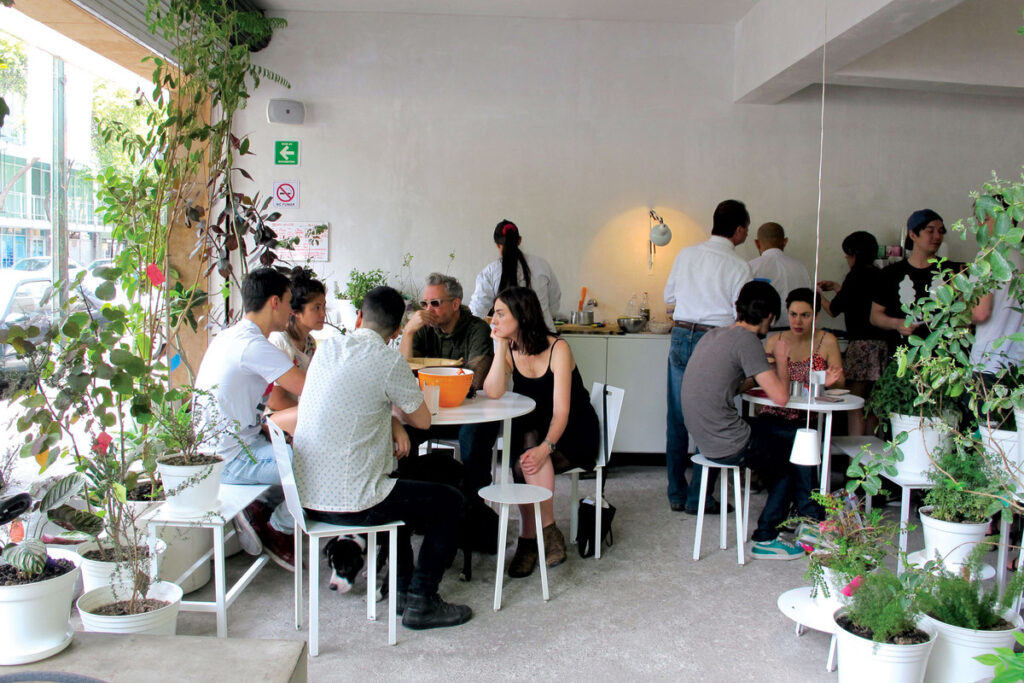
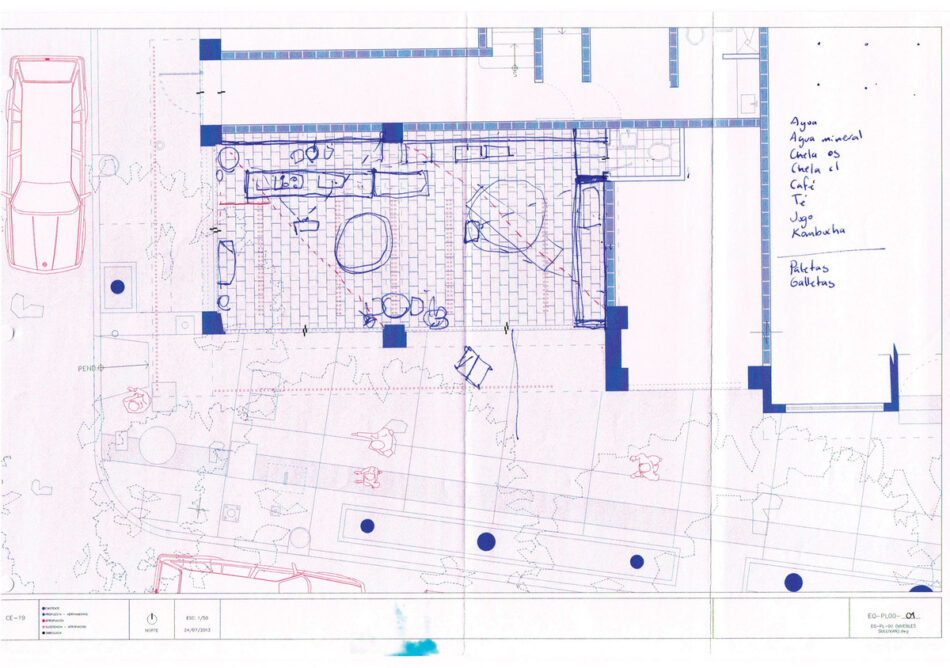
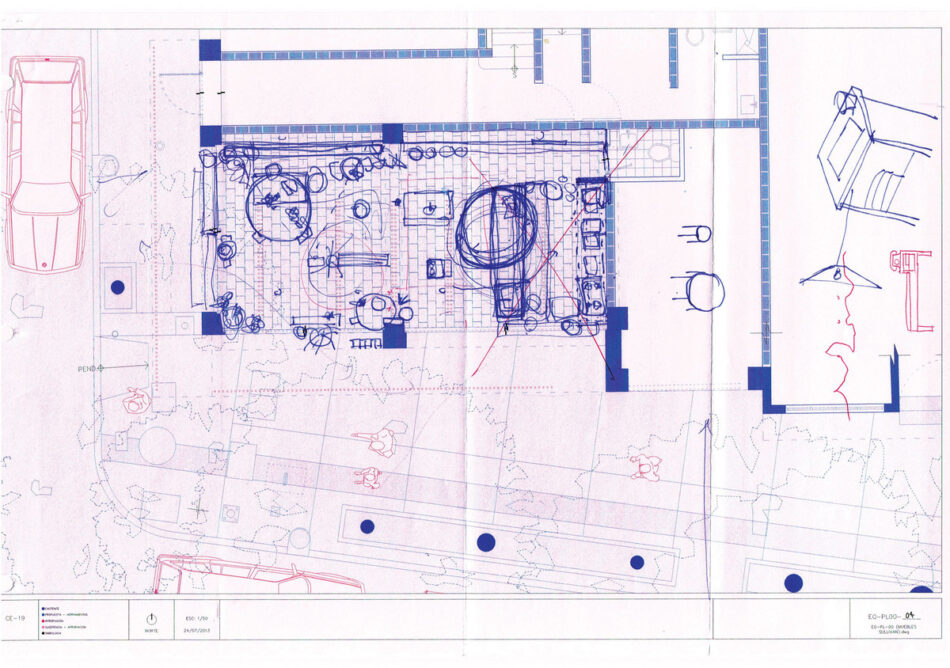
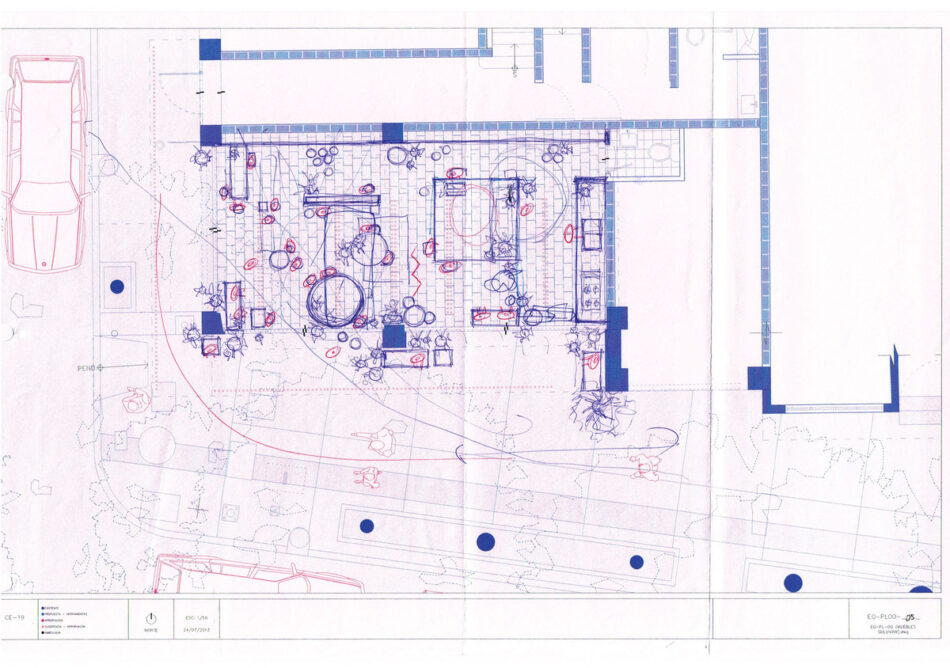
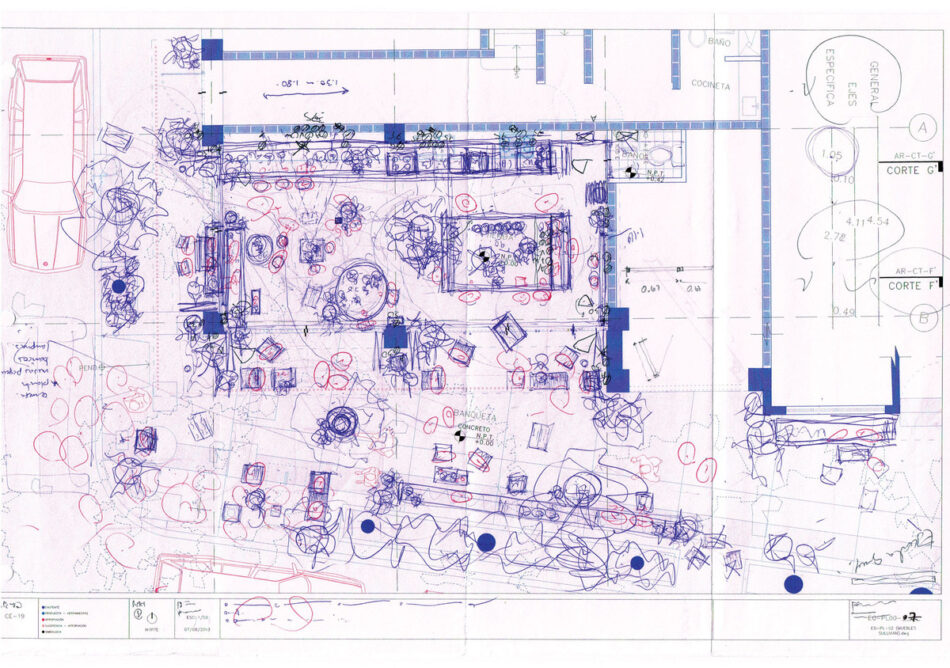
“These guys are just a bunch of questions! Great!” said the artist Mario García Torres about working with APRDELESP on the renovation of an apartment for him and his family.5 Excited by the prospect of a group of young architects opening a business to realize their first architectural project, he agreed to make a small investment (it helped that his studio is down the street and he’d been wanting a local lunch spot). While the interrogative mode comes naturally to the artist, who has earned his international reputation with laconic conceptual work, he was ambivalent about the survey
APRDELESP conducted of his belongings. The “inventory,” a signature of their process, involves making measured drawings of personal items—furniture, appliances, electronics, sentimental objects, whatever seems important. Practically, this presents a less varnished image of the client. Philosophically, it prioritizes the act of inhabitation. How, or by what means, do people occupy spaces? In a kind of sanctioned nosiness, the architect-anthropologists nonjudgmentally comb the stuff of everyday life, satisfying their curiosity, at least temporarily.
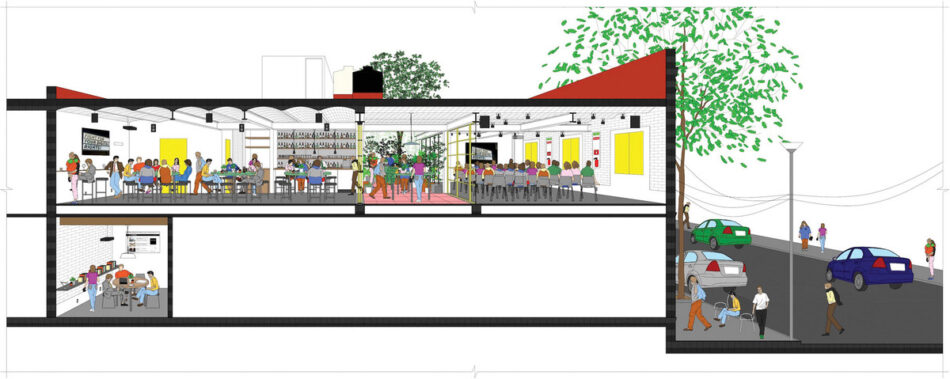
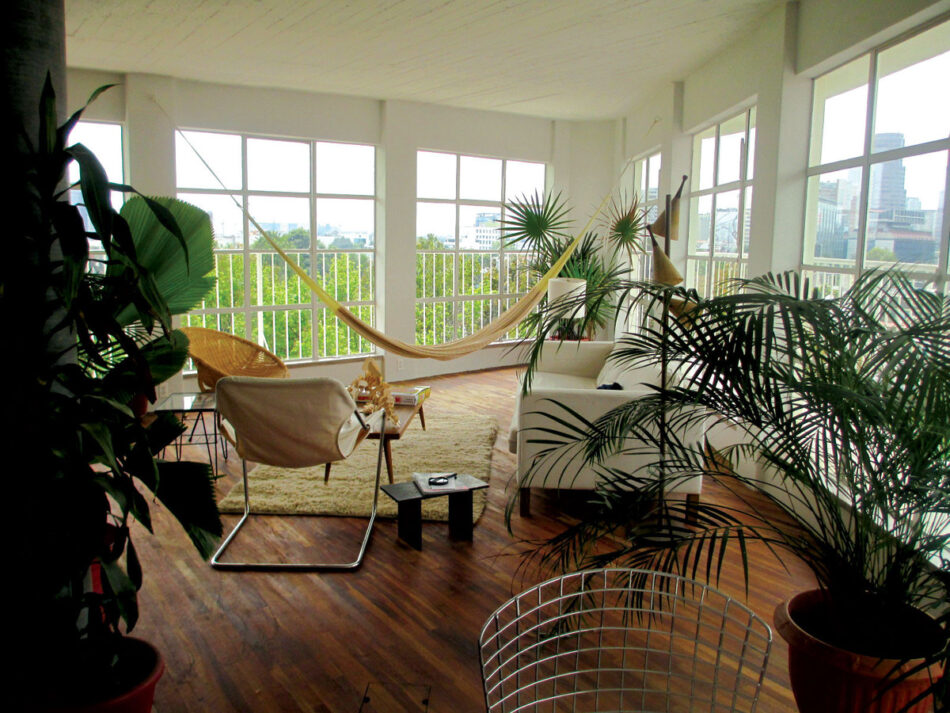
Brett Schultz, the director of Mexico City’s Material Art Fair, an annual showcase of small, independent galleries, received an assessment from APRDELESP completely unsolicited. The first time Schultz met Willy, at a party, the designer immediately offered blunt criticism of the 2015 fair, its second edition. Schultz was receptive. The 2016 edition, the first designed by APRDELESP, went too far with what he describes as a “mayhem vibe” (gallery booths owed directly into one another without corridors, creating a kind of labyrinth that had a strong impact but frustrated time-crunched collectors). Nevertheless, Schultz brought them back for this year’s fair. The design, still aisle-free, was more navigable, laid out like neighborhoods. “The whole point of doing an event like this is discovery,” says Schultz. “The mood is a reflection of an attitude that we share toward fair-making.”6
In many ways, these sympathetic client-architect relationships are an outgrowth of the ELHC subspaces and their intensive conviviality. Osorno doesn’t agree with all of the solutions for the Centro Horizontal renovation, which is curently being built, but he’s satisfied with 90 percent of the design and prefers not to fight over the other 10. (Pragmatists, ultimately, the architects have focused on reorganizing the circulation to permit independent activities to occur simultaneously.) APRDELESP doesn’t want to fight either, though that wasn’t always the case. Their first commissioned project, a restaurant interior, was a “disaster.” Adopting a “superhero model of architect,” a role they learned in school, the designers approached every argument expecting to win. When the client pushed back, communication sputtered out and morale plummeted. “That project changed our way of relating to clients,” said Willy. “We are not interested in collaborating in a way that we propose or sell something. It’s really important that they work with us.” He now believes you need to be able to let a lot of information change the product, to engage in a dynamic that is more intensive than idealistic.
I get what they mean. Still, I wondered why the conventional method was so disastrous. Was it some kind of existential disaster?
“No, nah, nah,” said Willy. “We don’t suffer.”
“Then why not keep working like everyone else works?” I asked.
“I do think we suffer,” said Ro. “I think that dynamic is very stressful.”
“The way it is now?”
“No,” said Willy. “The way it was before. It’s not that we are really frustrated—”
“I’m not saying you’re frustrated.”
“It’s not suffering.”
“Maybe it’s just not satisfying?” I asked. “Yeah, exactly.”
“It’s definitely personal,” added Ro.
Straying far from the professional mold, armed with strong personalities, they’ve earned a reputation among some local architects as irreverent punks, irritating delinquents. Or worse. “We were on a panel once,” recalled Ro, “and someone got really worked up about us not accepting that we’re, like, architectural terrorists or something.” Yet, in the many conversations I’ve had with the designers over the past couple of years, I have rarely heard them sound vengeful or patricidal. I wonder, too, if the overheated intergenerational combat that propelled so much creative work in the past is really that effective today. Once social and economic underpinnings—from property ownership to social security— become so in rm and untenable, as they are today for so many young people, you have to take a different tack. Anyway, why waste energy destroying what is already broken?
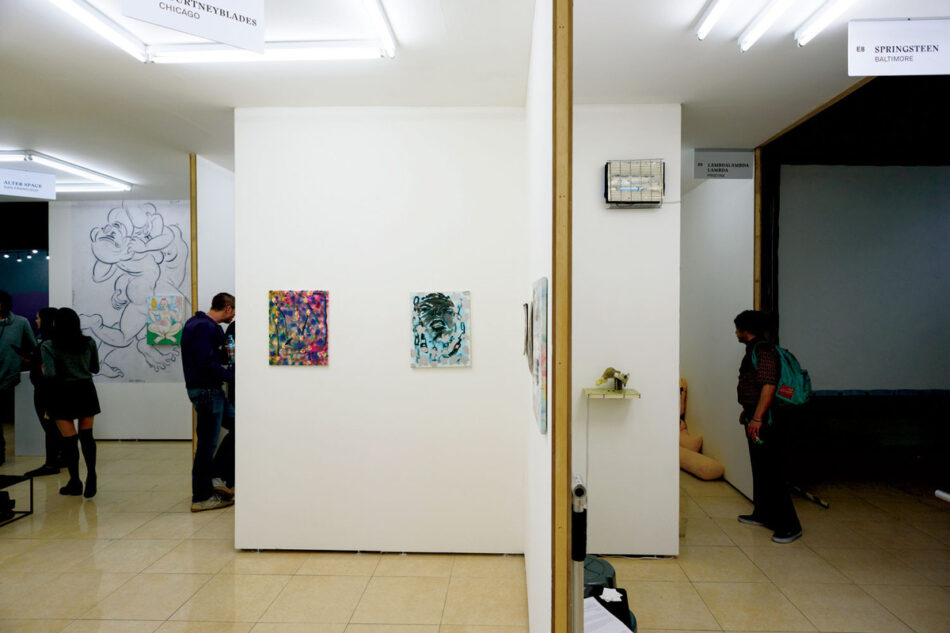
Going off script means you’re bound to be misinterpreted, however. “I think it’s very difficult to understand that we are an architecture office, and why we are posting flyers for karaoke nights,” said Willy. The graphics in particular, which mine an internet vernacular, are the most conspicuous affront to good taste (especially the good taste of architects) and a litmus for generational prejudice. While an older, more established person can traffic in juvenilia—and might even be cast, positively, as provocative and fresh—APRDELESP, by embracing its own time, is forced to go on the defensive. In architecture, the right to act young is earned with age; it’s a liability for the young to appear too juvenile. “We take everything very seriously, but on the outside it seems very . . . ,” said Ro, searching for the right metaphor. “It’s like being a goth kid in a very serious way. From the outside, you’re seen as a clown.”
Governments define the age when you can drink and vote and consent to sex. Most of us, though, know adulthood to be a bunch of learned behaviors and cultural expectations. Rather than an absolute age, youth is better expressed as the period before you are an adult, whenever that may be. This is the time that the community around ELHC, regardless of age, lives by. The time before you settled down and had kids; when kinship didn’t revolve so strictly around blood or law, and family was an elaborate web of friends—more pluralistic, capacious, queer; before your sense of possibility was blunted. A teenage mentality might not be comfortable, or even pleasant—anticipating all those learned behaviors and cultural expectations creates torrential anxiety—but it is a mentality that holds stubbornly to the belief that things can still change.
I ask Bree what makes ELHC special. “They’re really good at letting each other grow,” she says. Not only are they building spaces for people to use, but they’re allowing them to be used however people wish, without an agenda. Characterizing ELHC is difficult. While I tend to describe it as a collective or collaborative, in some important respects—like how the subspaces operate both as living experiments and experiments in living—ELHC is closer in spirit to a commune. Design is deployed as a tool to activate social relations, a means toward an optimistic end. But while a commune might suggest separation, a simulation of another society at a remove, ELHC makes its home within the city. Like a gang—a nonviolent and fun-loving gang, granted—it has discernible contours (age and fashion, most conspicuously), a passionate inner circle, and a powerful relationship to place.
I can envision the subspaces developing elsewhere in the world, assuming the right people are involved. It’s harder, though, to imagine ELHC having started somewhere else besides Mexico City, this big petri dish of problems and unfulfilled promises and possibilities. Guillermo Osorno, a journalist and editor who runs Horizontal, an online news-analysis site, echoes this sentiment. “The city lost hope in the ’80s,” he told me one morning over espresso at Centro Horizontal, a second-floor space in Colonia Roma where the publication hosts events and classes and runs a café.4 The malaise that set in with the 1985 earthquake and general economic and social crises was alleviated in the 2000s; Osorno believes ELHC’s subspaces are emblematic of the city beginning to reinvent itself. He was so impressed by the vision and scope of the project that he wrote a newspaper article on Café Zena shortly after it opened.
Meanwhile, as Centro Horizontal came to fruition, Osorno gained firsthand experience working with an architect. “His ideas, his views—always. And I had to pay,” Osorno recounted bitterly. The furniture was unsatisfactory, too. I witness the defects firsthand: the stools shake, the tables are too tall. Osorno was leery of working with another designer to improve the space, but a friend of his, the chef Gabriela Cámara, vouched for APRDELESP (they designed the offices of her restaurant group). He hired them in early 2017. An initial presentation, a distillation of the positive and negative aspects of the existing space, evolved into a series of weekly meetings held every Thursday. In the course of the conversations, Osorno and another Horizontal cofounder elaborated their “dreams, hopes, wishes” for the space. This is not far off from what most designers do, but Osorno and other clients I spoke with recall a unique kind of satisfaction.
In her recent essay “Kelly Lake Store,” writer and filmmaker Chris Kraus identified a tendency in contemporary art to- ward dislocation. Recounting her unsuccessful application for a Guggenheim Fellowship—her proposal to use the grant money to reopen a shuttered business in a depressed Minnesota town was rejected due to its commercial character—Kraus elaborates how transformations in the global economy have led artistic practices to absorb activities from far outside their traditional domains. For instance, as underground and independent cinemas have vanished, non-narrative filmmaking has migrated into galleries; with the deterioration of traditional newspapers, investigative journalism might end up as an installation. “Why would young people enter a studio art program to become teachers and translators, novelists, archivists, and shopkeepers?” Kraus asks. “Clearly, it is because these activities have become so degraded and negligible within the culture that the only chance for them to appear is within contemporary art’s coded yet infinitely malleable discourse.”7
In many respects, the artists and designers who keep ELHC’s shops and run the kitchens are representative of the phenomenon Kraus describes. Yet, for APRDELESP specifically, shopkeeping permits them to resist their own, comparatively less malleable, discourse and profession without abandoning it. Instead of jumping ship to someplace more accommodating—the art world has room for architect-artists—they’re devoted to changing the terms of practice, negotiating what’s presumed to be fixed and absolute. Rather than what artists make, the architects are curious about how artists work. Indeed, a quick look through the holdings of the ELHC library, a collection of pirated PDFs available on its website, reveals affinities with artistic movements like social practice, Fluxus, and relational aesthetics. What unites these interests is an explicit rewriting of the role of the artist and spectator and an expanded idea of creative activity, emphasizing duration and participation. Something similar is embodied in the firm’s original, unabbreviated name, Apropiación del espacio. They changed it after only six months, concluding it was too pretentious sounding, and haven’t looked back since, carrying on in their own exhilarating way, with incomparable inertia.
“The thing with change is not to change [only] once,” says Willy. “For example, a very basic thing like the name of your office: if you are not comfortable with the name of your office, but you have an image, people know you, if you don’t change the name, you are not able to change the name another time. You need to change everything, because if you don’t change you are not able to make further changes.”
David Huber is an architecture critic and editor based in New York City.
